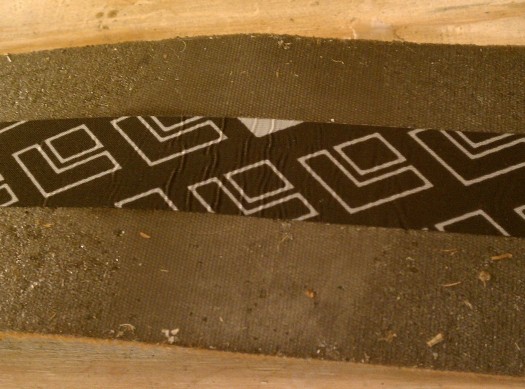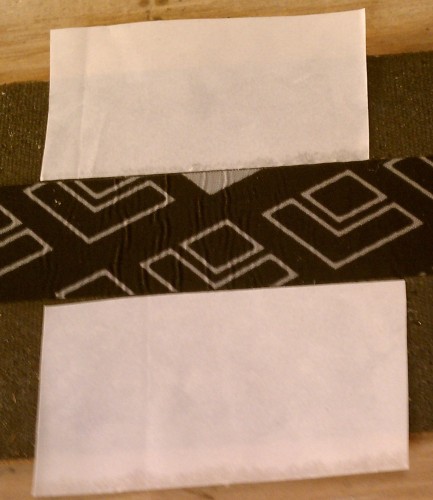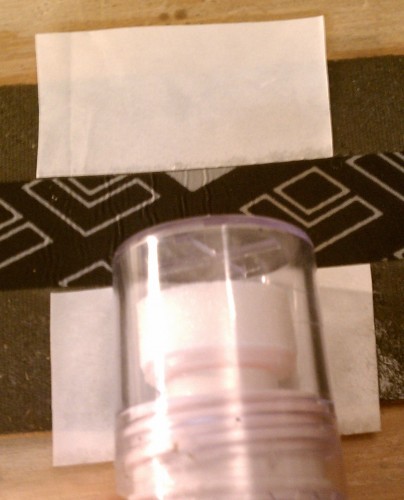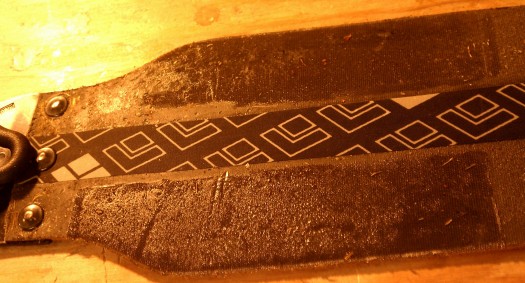New age guru self-help here at Wild Snow urging you to tap into your inner stickiness? Perish the thought! Instead, we’re on the prosaic fact that under certain circumstances, skin glue can truly be reactivated without regluing.
First, the easier fixes that have worked for me.
Glue inevitably picks up various bits of forestry. Those late-season below-treeline approaches can be really bad for this, ditto for skinning at New England ski areas after season closure. Especially large offenders can be picked out with your fingers or tweezers, but typically it is death by a thousand cuts — you’d drive yourself crazy trying to pick out every little offending item.
This repair is easy: Place a strip from a plain-old brown paper bag over the skin glue, run your hot iron over the bag, then lift away the brown paper that now contains your little friends from the woods. Depending on what is left behind, you might be able to get away without bothering to reglue.
Now for the main event. Several times I’ve had glue sections that simply would no longer stick reliably. Those sections were either nearly perfectly clean or the contaminants were too minor to explain the lack of adhesion. The glue was not missing, as poking around with a fingernail clearly revealed its original copious presence, although its original sheen had been transformed into a rather dull appearance. The bottom line is that the skin’s tack was simply gone.
My understanding is that this results from free water being pressed into the skin glue. And my experience with this certainly seems correlated with springtime skinning in super-warm temps.
Fortunately the fix is easy (and is essentially the final set of steps in hot reglueing):
1. On the offending sections, put down the white release paper that originally came with your BD skins. (You did save all of that, didn’t you? If not, try BD customer service.) Be sure to place the slicker side against the glue. The difference between the two sides is somewhat subtle, yet important!
2. Place your hot iron over the release paper until you sense that the glue on your backcountry skiing climbing skins is becoming somewhat molten. Several seconds should do the trick.
3. Roll the skin+paper combo with a rolling pin or some other hard cylindrical object. In the picture I’m using liquid wax container, but I should buy a dedicated rolling pin for this.
4. Remove the release paper to reveal some nicely pressed-in glue with its original sheen and tack restored. (Rarely the release paper doesn’t release all that cleanly, and you’ll need a re-do.)
Accomplishing all of the above steps takes less time than typing them out here. (But be sure to let the skin cool down completely – and then some – before skinning or even just sticking to itself.)
Despite our optimistic how-to described above, sometimes you really do need a reglue. This necessity can arise if glue has been stripped off the skin backing when it stuck to the ski base (rarely) or to the other side of the skin (which can be prevented during longer-term indoor storage by using mesh “cheat sheets”).
When the need to reglue does arise, personally I prefer to keep as much of the original glue on the skin. So I clean with a brown paper bag as much as I can then scrape off the glue only from those sections that look hopeless. Others like to start anew by removing all the original glue (which supposedly can be done by dry cleaners – trust, but verify). Either way, use plenty of ventilation, preferably outside. (A garage with open bays, doors, and windows works well, as does a screened-in porch; no bugs in the glue.)
A few sentences about a super-quick and easy yet one-time fix with BD skins: The commonly termed “glueless” strip is really a taped-over strip. Easily remove (even in the field) that section of plastic-like fabric running down the center to expose 100-percent fresh glue. But since this fix works only once, I prefer to save it for emergency purposes in the field.
Happy skinning and backcountry skiing!
(WildSnow guest blogger Jonathan Shefftz lives with his wife and daughter in Western Massachusetts, where he is a member of the Northfield Mountain and Thunderbolt / Mt Greylock ski patrols. Formerly an NCAA alpine race coach, he has broken free from his prior dependence on mechanized ascension to become far more enamored of self-propelled forms of skiing. He is an AIARE-qualified instructor, NSP avalanche instructor, and contributor to the American Avalanche Association’s The Avalanche Review. When he is not searching out elusive freshies in Southern New England or promoting the NE Rando Race Series, he works as a financial economics consultant.)
WildSnow guest blogger Jonathan Shefftz lives with his wife and daughter in Western Massachusetts, where he is a member of the Northfield Mountain and Thunderbolt (Mt. Greylock) ski patrols. Formerly an NCAA alpine race coach, he has broken free from his prior dependence on mechanized ascension to become far more enamored of self-propelled forms of skiing. He is an AIARE-qualified instructor, NSP avalanche safety instructor, and contributor to the American Avalanche Association’s The Avalanche Review. When he is not searching out elusive freshies in Southern New England, he works as a financial economics consultant.




